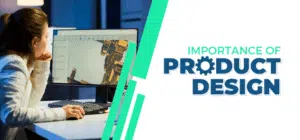
Product design is a set of strategic and tactical activities that cultivates ideas for product commercialization. It combines art, science, and technology to create new products. Product designers conceptualize and evaluate ideas in a systematic manner, transforming them into tangible inventions and products.
The forecasted market of product design and development is expected to be USD 8.21 billion by 2029, with a CAGR of 5.30%. This suggests that the integration of growing technology with product design will boom in the upcoming years. This is also because developing distinctive products significantly to sales revenue.
The objective of product design is to create a product or service with superior functional utility and sales appeal at a reasonable price and in a reasonable amount of time. To understand its importance more precisely, keep reading.
What Is Product Design?
Product design is defined as the process of imagining, creating, and iterating products that solve users’ problems or address specific market needs.
Understanding the end-user, or the individual for whom the product is being created, is essential for successful product design. Product designers use empathy and knowledge of their prospective customers’ habits, behaviors, frustrations, needs, and wants to solve real problems for real people.
Example Of Product Design
When it comes to product design development, designers have numerous options for tools. Before going into production, they can use the conventional method of sketching out concepts on paper and then creating models. Frequently, contemporary designers create 3-D computer models using specialized software that simulates the final appearance of the object.
The best example of product design is Belt Testing Gang Dynamometer Machine, a special-purpose machine made by Technosoft Engineering. The scope of this project was to design a Gand Dynamometer for accelerated failure testing of one-size drive belts. This machine will be able to test 4–8 belts at a time.
The dynamometer integrated mechanical and electrical designs to monitor, record, and notify the belt failure or in case of exceeding a defined percentage of slippage.
What Is The Product Design Process?
There are three basic steps involved in the product design development process.
- Analysis
- Acceptance: Here, the designers commit to the project and find a solution to the issue. They combine their resources to determine the most effective solution to the problem.
- Analysis: In this phase, everyone on the team conducts research. They collect general and specific information that will aid in determining how to solve their problem. This can include, among other things, statistics, questionnaires, and articles.
- Concept: This section defines the central issue of the matter. The problem’s conditions become objectives, and the situation’s constraints become the parameters within which the new design must be developed.
- Synthesis
- Ideate: Here, the designers generate various ideas and solutions for their design problem. The ideal brainstorming session is devoid of bias and judgment, instead focusing on developing original concepts.
- Select: At this point, the designers have narrowed their ideas down to a select few that are guaranteed to be successful, and they can now outline their plan for creating the product.
- Implement: At this stage, prototypes are constructed, the plan outlined in the previous step is realized, and the product begins to take on a physical form.
- Evaluate: In the final phase, the product is evaluated and improvements are made based on the results. Even though this is the final step, the process is not complete. The finished prototype may not function as expected, so it is necessary to generate new ideas.
Why Is The Product Design Important?
Product design is not limited to the product’s aesthetics; it also defines how the product functions.
- If your product design is superior to that of the competitor, it will be chosen over the competition on the market.
- Product design is essential because it provides the consumer with an original and imaginative experience. As a result, the design of the product can attract new customers and foster brand loyalty. The design of a product can go a long way toward creating a memorable experience, which in turn fosters brand loyalty.
- Design is crucial in heavy machinery and services because it can be the difference between efficiency and chaos.
- Product design is a crucial component of the product development procedure. It ensures that the final product is customer-friendly, aesthetically pleasing, and profitable to produce.
- Design can take many forms, and the greater the acceptability of the product’s design over time, the stronger the organization’s brand will be.
- Packaging plays a significant role in product design because it is the final point of influence and, therefore, the company’s final sales point. Good packaging integrated into the design of a product can make a substantial difference.
Get GenX Product Design Development Solutions Here
As mentioned above, product design is the USP of a business, and it needs to be uniquely perfect. So to meet that need, Technosoft Engineering gets you the best solutions. Our process starts from idea generation to execution. We aim to reduce the cycle time and increase the scope and functionality of the product.
Our product design services include market research, product styling, DFA, DMF, reverse engineering, prototyping, material selection, engineering change management, and product costing. You get a solution bundle in one place.So, wait no further and get feature-rich unique product design solutions.

